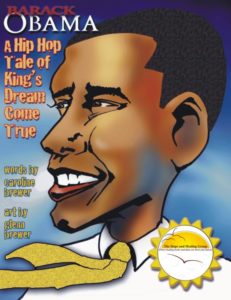In honor of President’s Day and the need to learn about presidents 365 days a year
***
Five Things About Barack Obama:
A Hip  Hop Tale of King’s Dream Come True
Hop Tale of King’s Dream Come True
In a nutshell: The artwork is a conversation starter; it has 60 sets of rhyming words (sure to send any child’s vocabulary and comprehension soaring); you can teach more than a dozen English language learning skills; it’s full of surprises, including fun facts about animals; and opportunities to learn about social activism and politics in ways that are very cool. (To purchase, click here.)
Get the deets below:
- The first thing you should know is that your young people are going to LOVE the artwork in this book. The colors and illustration style will make children’s eyes pop! And the moment they are captivated by a book’s illustrations is your first teachable moment. If you have young students, say ages 4 -6, you can take a picture walk with them through this book and discuss what they see happening in the illustrations. And you can use this exploration to write key words and phrases from the book that you can teach children to recognize and read. Students, like adults, are deeply attracted to and heavily influenced by color.
- The second thing you should know about Barack Obama: A Hip Hop Tale is that one of the most powerful educational tools embedded in this book is its 60 sets of rhyming words, such as these: street, meet, feet, hope, cope, say, day, fear, dear, skin, within, frogs, dogs, hogs, flap, nap, night, fright, uptight, light, soon, moon, ear, near, air, fair, all, fall, down, around, sound. We know that children love rhymes because they’re fun. But research tells us that rhyme builds memory, vocabulary, and confidence faster than any other reading technique. Confidence is crucial in helping “hungry” readers see themselves as fluent, successful readers. Nursery rhymes are introduced to children at infancy and help them take their first steps up the ladder of literacy. The thing I love most about rhymes is what Author Jim Trelease revealed. He said rhymes are “comfortable, predictable,” and “the closest things to a mother’s heartbeat.” How cool is that?
- The third thing you should know is that you can boost, enhance, and teach your students dozens of English language skills using this book alone. No matter your students’ ages or grades, from kindergarten to 12th grade, lessons abound. Unlike some children’s books that are written strictly for a certain age group or reading level, BO: HHT gives you a variety of sentence lengths and styles. Declarative, Imperative, Interrogative, Exclamatory, Complete, Compound, and Complex Sentences can be found in this book. Not to mention compound words, onomatopoeia, and all sorts of grammar conventions that are taught from K – 12.
- You can begin or extend your students’ knowledge of fun facts about animals with this book. There are three types of animals in the book: frogs, rats, and crows. You will see that the way the animals behave in the story life is consistent with their behavior in real, natural life. For instance, in BO: HHT, we see frogs taking a piggyback ride, lounging in trees, flying through the air, and making lots of loud noises. Real frogs do all of these things. In fact, although we mainly think of frogs as jumpers, turns out that frogs can launch themselves more than 20 times their own length. That would be similar to an adult jumping 100 feet! Imagine that. Frogs also are noisy little beasts. In fact, some frogs make so much noise they can be heard for miles. Frogs’ ears are connected to their lungs and that keeps them from blowing out their eardrums while they make all that noise.
- You can begin or extend your students’ social studies and current events education with this book. You can discuss and use the book to teach the election process, the Electoral College, governmental structure, the economy, health care, education, drugs, crime, justice, and neighborhood activism. You can discuss our nation’s history as it relates to African Americans, Indigenous people, Latinos, Asians and their experiences in politics. Moreover, you can guide students through comparison and contrast between Martin Luther King, Jr. and Barack Obama.
The possibilities are endless. Enjoy the journey!
